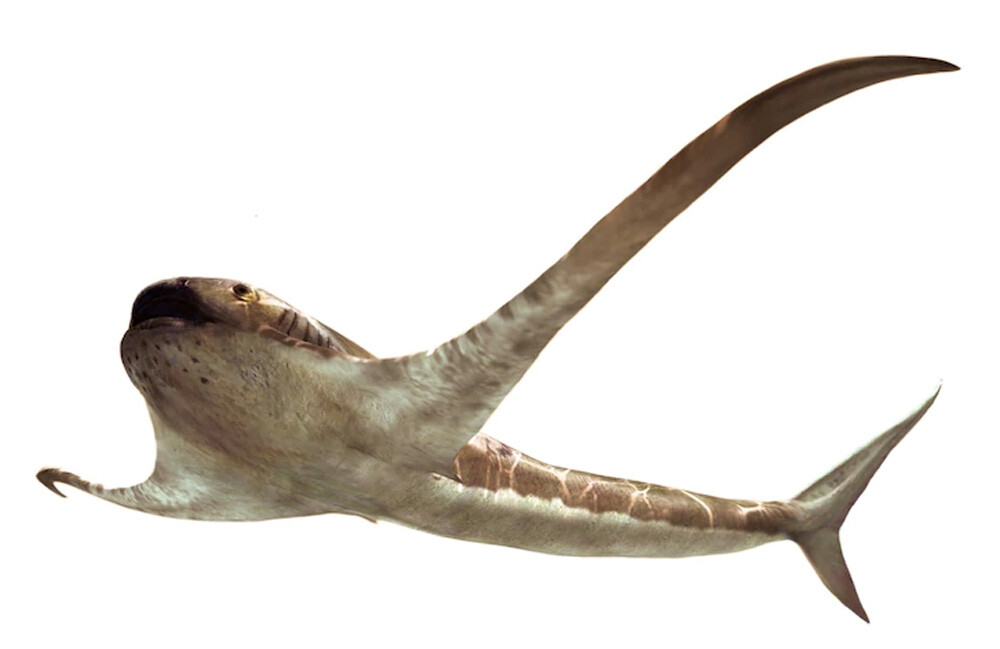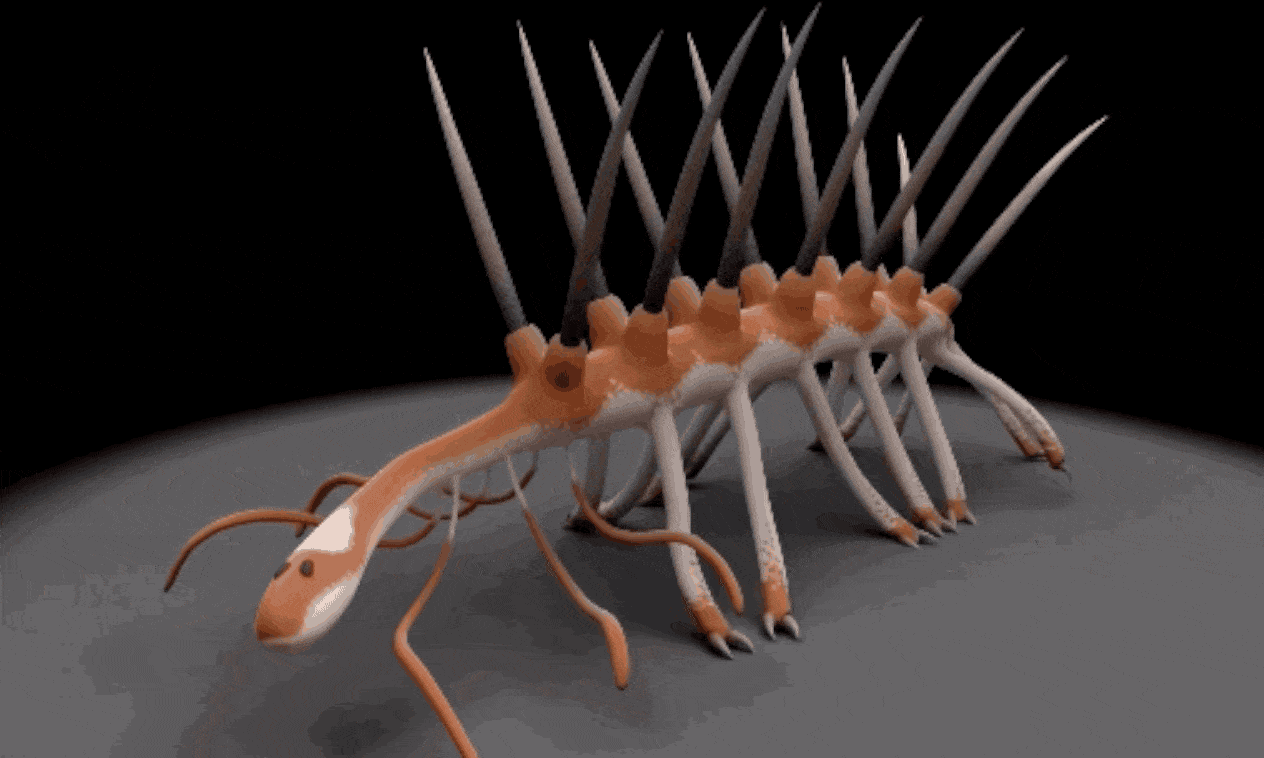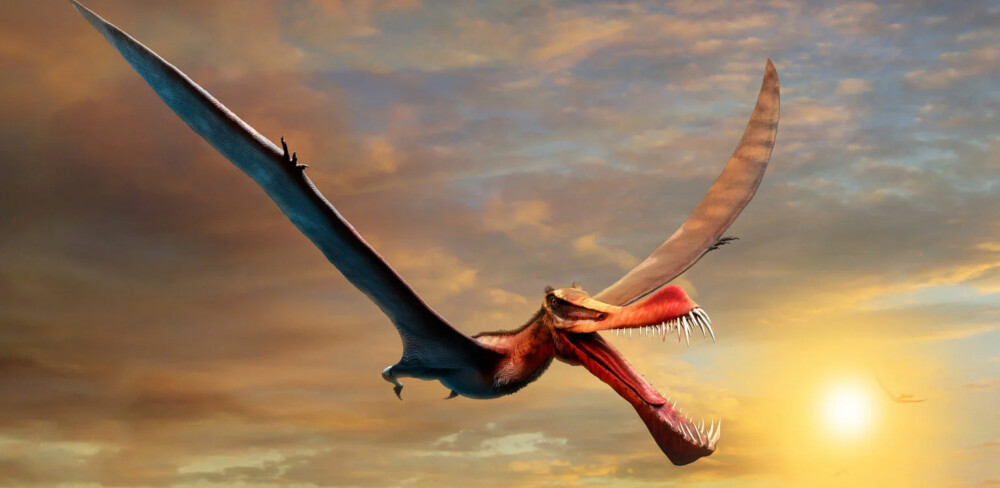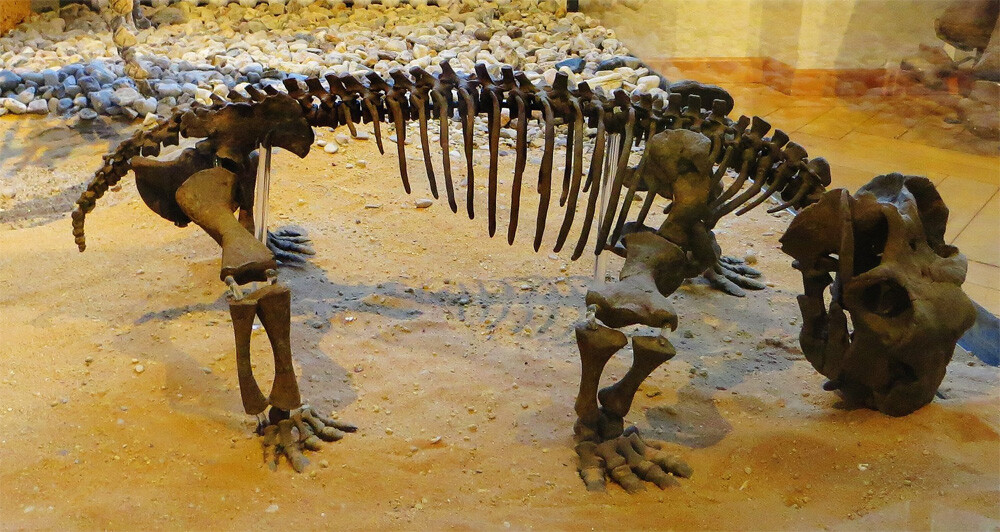7 Terrifying Prehistoric Creatures That Mother Nature Made While Drunk

Mother Nature is a noble artist who creates majestic works. But that's how many famous artists started before developing a raging substance abuse problem and madly flinging paint (and body fluids) at a canvas. Similarly, at some point, Mother Nature clearly went on a furious alcohol-based bender while designing the following ancient beasts.
The Creepy Toothless Eagle Shark
During the mid-Cretaceous period, circa 90 million years ago, the continents were a bit soggy. There were no ice caps, and all that extra H2O raised sea levels by 500-650 feet. Gigantic marine reptiles proliferated, and the fearsome "eagle shark" prowled the ocean depths in what is now a very above-water portion of northern Mexico.

We know, all animals are nude, but this one knows it, and likes it.
OK, maybe "fearsome" is the wrong word. It is creepy, though, with those awful wings that span 6-feet-across, compared to its 5-foot length. Even though its wing-like pectoral fins looked long and unsettling, they were just an evolutionary beta version of the wings on modern manta rays and such. Mantas flap them in an oscillatory fashion to move around, but ol' eagle shark may not have been able to move its fins. Instead, it used them to keep its hydrodynamic gliding balance, like a little airplane-shaped submarine.
And its tail doesn't match that of fast-maneuvering, predatory sharks. So, even if it somehow survived the dinosaur-killing asteroid (not to mention the rest of the intervening 93 million years separating it and us), it couldn't chase down complacent surfers like any real shark worth its salt. Nor would it want to, it seems. In addition to its limp little fins, it sported a blunt, stumpy head with either no teeth or teeny-tiny baby teeth; a real plankton-eater's head. It likely went about its planktivorous routine like an aquatic Roomba, lethargically drifting back and forth while scooping up the small sea critters floating about.

Bajadasaurus, The Spiked Sauropod
Sauropods, like the universally beloved brontosaurus, generally didn't have spikes, horns, frills, or other flamboyant adaptational add-ons. And they didn't need them—they were the chillest of dinosaurs. Plus, since they weighed hundreds of thousands of pounds, they were so muscular and dense that their bulk (or a boot to the face) deflected jaws and claws.
But the 140-million-year-old Bajadasaurus pronuspinax (surname meaning "forward-pointing spines" because, spoiler alert, it had forward-pointing spines) had, as you may have heard, a frickin' sweet set of forward-pointing spines.

Argentina Ministry of Science
Or so scientists think, according to a vertebra they found with a forward-pointing spine on it, unlike basically all the dinos who sported backward-pointing spikes. Scientists also extrapolate the medium-sized sauropod's appearance based on a similar, related dinosaur, the Amargasaurus, which had two rows of spines on its back. Potentially, these served as supports for two thin sails that ran down Amargy's back.
Similarly, the pronuspinax's spikes (some of which could have been over five feet long) may have supported some sail apparatus whose large surface area would have dissipated heat and let the 40-foot dino escape heat stroke. Or maybe the spines held some fat-storing bodily structure, like a camel's hump, to fuel the plant-munching beast's immense metabolism.

Alternatively, the spikes could have been a deterrent for hungry predators. Or the opposite of a deterrent for thirsty pronuspinax ladies. After all, some argue that all the seemingly weaponized dinosaur appendages, like horns, grew more prominent for sexual advertising rather than brawlin'.
The Hallucinogenic Hallucigenia
Most prehistoric creatures have arcane names that reference their obscure discoverers in some irrelevant language no one wants to use anymore, like Greek. But hallucigenia's name instantly describes this little, 508-million-year-old critter's psychedelic nature:

Hallucigenia specimens were tiny, from less than an inch to maybe an inch or so. But these thumb-sized, deep-water creepy-crawlies packed more physical weirdness-per-volume than arguably any other creature known to science.
We discovered them about 110 years ago, but up until the 1990s, we thought those spikes were its legs. Those other tentacle-y appendages, well, we'd figured they must have sprouted wildly from its back for some unholy reason known only by the sulfurous dark lord himself. It then took another 25 years for scientists to formally and officially locate its head. What they previously thought was its head (a blob at one end of the fossil) turned out to be "decay fluid." The was poo squeezed from its gut as it was buried under mud those hundreds of millions of years ago.

Jose Manuel Canete
But thanks to electron microscopy, scientists finally confirmed its goofy tiny head. It sported two simple little eyes that could have distinguished light from dark and seen some rough shapes but possibly not too much else. A minuscule, tooth-ringed mouth led to a gullet lined with small, backward-pointing teeth that acted like a spike strip to keep plankton from escaping its gut-throat.
Hey, if evolution managed to pack so many kinks packed into a wormlet-sized creature, maybe it’s no wonder that humans are attracted to feet.
Terrible Pterosaurs
Pterosaurs, or flying reptiles, are horrible and we hate them. One pterosaur we especially hate is Thapunngaka shawi, whose name means "spear mouth" in First Nations Wanamara lingo, on account of its 40 murder-fangs:

Old spear-mouth, described as a real-life dragon, antagonized the inferior ground-and-sea-creatures of the Aussie outback about 105 million years ago. It had an enormous, death-tooth-filled head attached to two gigantic wings that spanned 30 feet across.

But what could be worse than a dragon-headed pterosaur swooping down on you? Several dragon-headed pterosaurs swooping down on you. These horrible, horrible monsters lived in groups, according to a find in southern Brazil: a boneyard of nearly 50 pterosaurs.
The Caiuajara dobruskii only had an 8-foot-wingspan, so these toothless terror-saurs were smaller than their Victoria Bitter-swigging Aussie counterparts. But, unlike their airborne kin, they had incredibly creepy bone crests jutting from their disgusting faces that we hate. The boneyard held adults as well as juveniles—it was an ultra-rare find to get them together and compare their growth, because it allowed scientists to surmise that the precocious babies are born flight-ready. So, Jurassic Park 8 better have the public pecked to death by baby pterodactyls.
Radiodonts
About 540 million years ago, the Cambrian Explosion exploded, and loads of complex organisms mysteriously and suddenly appeared after billions of years of evolutionary thumb-twiddling. Multiple causes are claimed, from oceanic oxygen or mineral fluctuations (like DNA-supporting phosphorus), to benevolent alien visitors imbuing Earth with their life-enriching space-jizz. What's certain is that some of the emerging animals were creepy as hell.
Deadly, too. Exhibit A: the "elongated prawns" known as radiodonts. One of their defining features is a pair of mouth appendages with radiating sets of teeth:
These backbone-less arthropods came in a great variety of sizes, from a few inches to about 6 feet. Also, various shapes, which is especially impressive given that not many millions of years prior, life was limited to tiny floaty things, goo, and bathmat-like bacterial colonies.
Some ate plankton, some ate worms and such, and others were the raptorial predators of the ancient seas. Like the 3-foot-long killer shrimp Anomalocaris, who quickly earned top dawg status due to a major advantage: complex compound eyes consisting of more than 24,000 lenses, and any compound eye back then was the modern equivalent of getting pre-release Jordans. In fact, its eyes were so badassedly advanced that their growth hasn't changed in the 500-plus million years since.

These seemingly anachronistically and insanely sophisticated eyes may have actually kicked off an evolutionary arms race, forcing lesser sea-creatures to evolve to catch up and not get wiped out by the dead-eyed, murderous radiodonts.
Lystrosaurus
We owe our existence to a long, unbroken lineage stretching back billions of years. But evolution is often unglamorous, and some of the (distant) relatives of mammals are less than magisterial. Case in point, lystrosaurus. This corgi-to-cow-sized creature unassumingly survived the worst mass extinction in Earth's history, by digging itself into the ground and taking a nap.

Members of the lystrosaurus genus, whose fossils inhabit rocks from 253-248 million years ago, were therapsids. These reptilian proto-mammals eventually gave rise to mammals proper. They were dicynodonts, Greek for "double dog-tooth," which, along with the name lystrosaurus, Greek for "shovel lizard," reveals two things. One, you're learning a lot of ancient Greek today. Two, the dopey-looking, plant-chomping lystrosaurus sported two tusks and a turtle-ish beak.
These wispy-mustache-hair-covered weirdos inhabited China, India, Russia, South Africa, and an ice-free Antarctica when these locales were interjoined in the mega-continent Pangea. With such scattered habitations, it may have simply outwalked the extinction and found the least lethal places to live. And its body type suggests it was an accomplished burrower. It also sported big lungs, which let it tolerate the post-doomsday atmosphere and presumably take massive bong rips.

Also, its unspecialized nature made it adaptable to shifting conditions. Because usually, the most specialized of creatures were the worst-affected by Earth's numerous extinctions. And based on the rings in its bony tusks (like tree rings), it may have also engaged in torpor, a form of hibernation.
Altogether, these individually unimpressive traits allowed it to outlast the most catastrophic event of all time. So there you have it—a distant mammalian relative ensured an immense variety of modern animals, hundreds of millions of years into the future, by napping through the apocalypse.
The Upright Crocodile
Prehistoric animals are almost always more horrible than modern variants. That even goes for crocodiles. Yes, they're already some of the most vicious, ferocious creatures to plague our lovely blue planet, but they're much cuddlier than their nightmare-inducing ancestors:
Carnufex carolinensis was a crocodylomorph, or a crocodilian great-great-great-(and so on)grandpa. Only, it wasn't content to carpet the swamps and floodplains, waiting for chicken leg–dangling hillbillies to slip off their airboats. It walked on land. Walked, as in bipedally. It was also nearly 10 feet long and a real schoolyard bully, preying on tiny mammals and reptiles.
It's known as the "Carolina butcher" because it lived in North Carolina 230 million years ago, when the Tar Heel State was a humid equatorial region seceding from Pangea as it later did from the Union. And since the enormous, Hollywood-worthy dinosaurs hadn't evolved yet, the butcher enjoyed top roost for a while.

As the Triassic wore on, the butcher lived alongside the growing dinosaurs. Then, both the big crocodiles and the big dinosaurs died when an extinction drew the curtain on the Triassic 201 million years ago. Afterward, the dinosaurs took over the big-money predatory niches for the next 135 million years, while crocs grew smaller and scavenge-ier, resembling modern foxes but with alligator skin.
And through force of will and luck, both lineages managed to survive another extinction, the asteroid-assisted one of 66 million years ago. Crocodilian kin turned into fierce modern crocodiles, while the caprices of evolution sent theropods in the other direction:

Top image: Jose Manuel Canete
